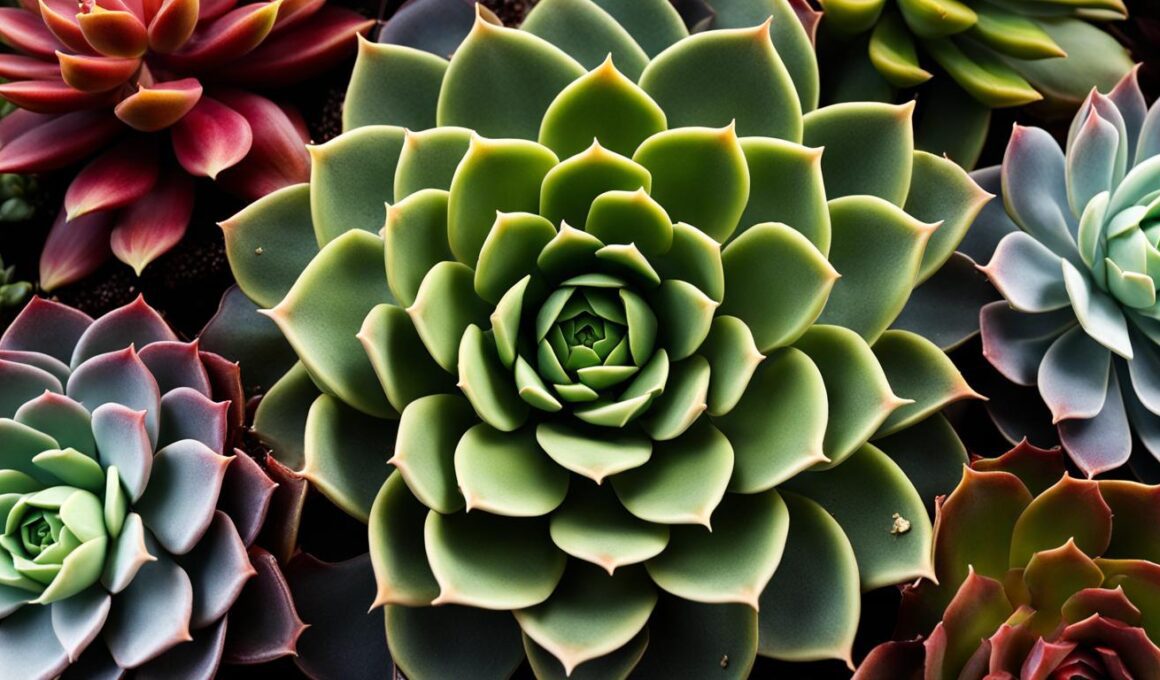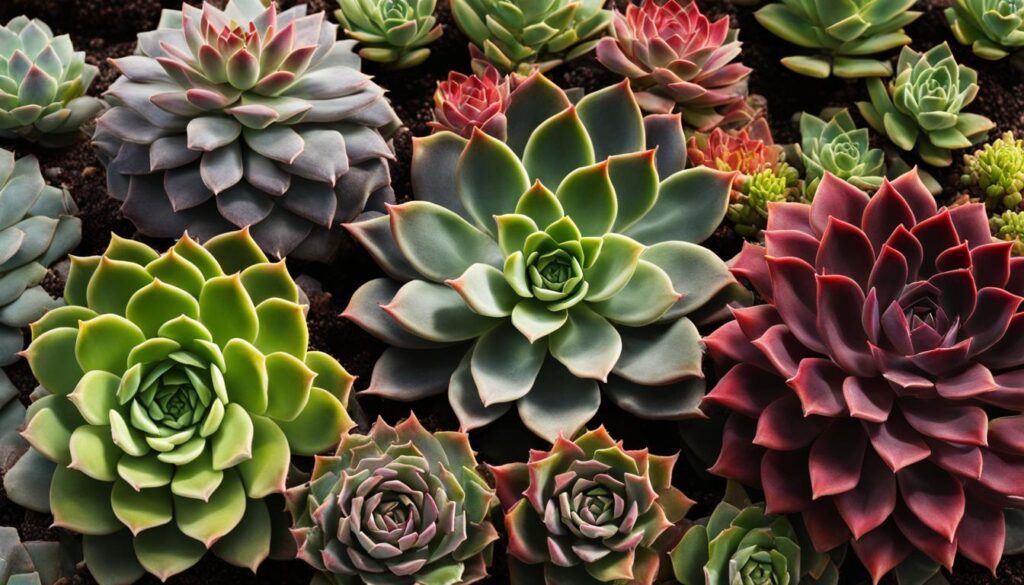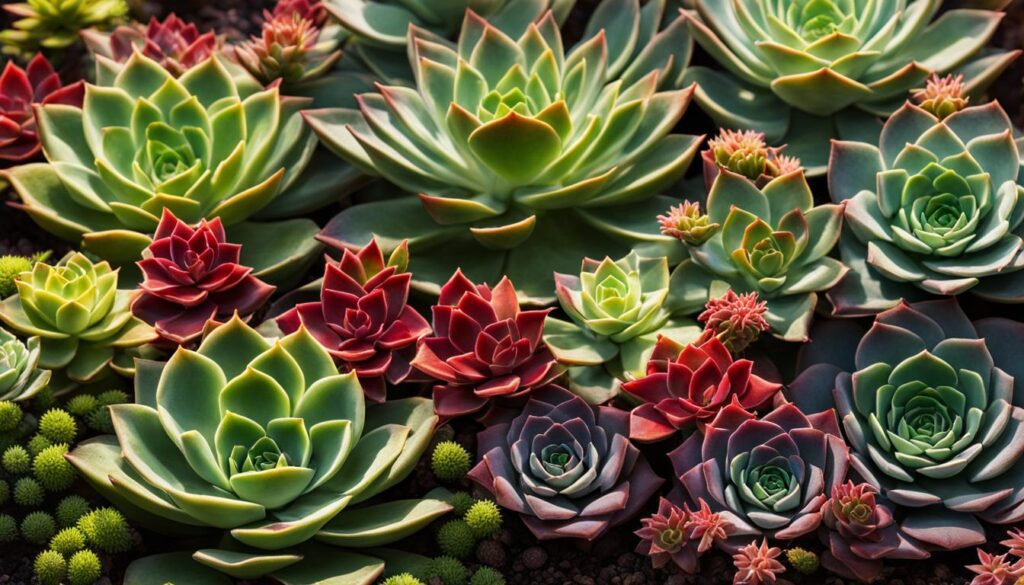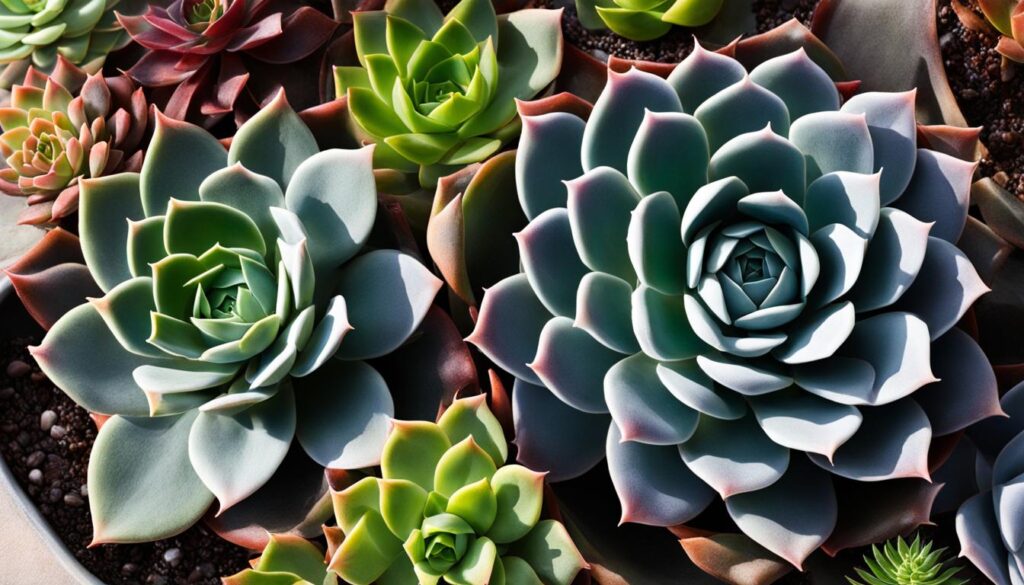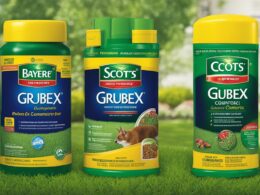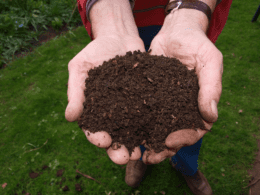Are you a succulent enthusiast? If so, you’ve probably come across Echeveria and Aeonium, two popular types of succulents that often leave gardeners puzzled. While these plants belong to the same family, Crassulaceae, they possess distinct characteristics that set them apart. In this article, we will delve into the world of Echeveria and Aeonium, exploring their unique qualities and uncovering their similarities. Get ready to explore the captivating beauty of these succulents and select your favorite for your collection!
Post Summary
- Echeveria and Aeonium belong to the same family, Crassulaceae, but have unique characteristics that differentiate them.
- Echeveria is known for its rosette-shaped growth habit and spoon-like leaves, while Aeonium has tall stems and pointy leaves.
- Aeoniums generally grow larger than Echeverias, reaching up to 3 feet in height and width, compared to Echeveria’s smaller size of around 6 inches.
- Echeveria is a more prolific bloomer, producing flowers multiple times throughout its lifetime, while Aeoniums bloom only once and then die.
- Echeveria is native to North, Mexico, and South America, while Aeoniums originate from the Canary Islands, Africa.
Echeveria: Beautiful Rosettes with Striking Leaves
Echeveria succulents are known for their gorgeous rosette-shaped growth habit and striking leaves. Native to North, Mexico, and South America, Echeveria thrives in desert conditions but can also tolerate some moisture. One of the distinguishing features of Echeveria is its plump, spoon-like leaves with smooth edges. These leaves can vary in color from blue-gray to vibrant green and may have a powdery surface. Echeveria is also a polycarpic plant, meaning it blooms every year, producing bell-shaped flowers in shades of pink, peach, orange, white, or yellow.
| Echeveria | Aeonium |
|---|---|
| Smaller size (around 6 inches in height and width) | Larger size (up to 3 feet in height and width) |
| Prolific bloomer (produces flowers multiple times) | Monocarpic bloomer (blooms only once) |
| Polycarpic plant | Monocarpic plant |
Native Habitats and Climate Preferences
Echeveria and Aeonium thrive in different native habitats and have specific climate preferences. Understanding these factors is essential for providing optimal care for these succulent plants.
Native Habitats
Echeveria is native to North, Mexico, and South America, where it adapts well to desert conditions. These regions have arid climates, with low rainfall and high temperatures. Echeveria has developed mechanisms to store water in its leaves, allowing it to survive in these dry environments.
Aeonium, on the other hand, is originally from the Canary Islands, Africa, and can also be found in other parts of the world such as Morocco and East Africa. These plants have adapted to different climatic conditions, including mild winters and moderate rainfall.
Climate Preferences
Echeveria prefers regions with Mediterranean climates, characterized by dry summers and mild, rainy winters. These plants require well-draining soil to prevent excess moisture and root rot. They can tolerate some moisture but should not be overwatered.
Aeoniums, being native to islands like the Canary Islands, are more adapted to drier climates. They can withstand long periods of drought and are more cold-hardy than Echeveria. Aeoniums can tolerate temperatures as low as -40 °C, making them suitable for colder climates.
Native Habitats and Climate Preferences
| Succulent | Native Habitat | Climate Preferences |
|---|---|---|
| Echeveria | North, Mexico, and South America | Mediterranean – dry summers, mild, rainy winters |
| Aeonium | Canary Islands, Africa, Morocco, East Africa | Dry climates, mild winters, moderate rainfall |
Understanding the native habitats and climate preferences of Echeveria and Aeonium is crucial for their successful cultivation. By providing the right conditions, you can ensure that these succulents thrive and display their unique beauty.
Light and Temperature Requirements
Echeveria and Aeonium have different light and temperature requirements that are crucial for their optimal growth.
Echeveria:
Echeveria can tolerate bright light but also grows well in partial shade. It is important to place your Echeveria in a location where it can receive at least 6 hours of bright, indirect sunlight each day. If you notice that the leaves are stretching or becoming pale, it may be an indication that the plant is not receiving enough light. On the other hand, if the leaves are getting scorched or turning brown, it may be a sign of too much direct sunlight. Adjust the placement of your Echeveria accordingly to ensure it is getting the right amount of light.
In terms of temperature, Echeveria prefers temperatures above freezing and is more sensitive to frost. Ideally, the temperature should range between 60°F to 75°F (15°C to 24°C) during the day and 50°F to 60°F (10°C to 15°C) at night. Avoid exposing your Echeveria to extreme temperature fluctuations, as it can cause stress and damage to the plant.
Aeonium:
Aeoniums require some hours of direct sunlight to thrive. It is recommended to provide them with at least 4 to 6 hours of direct sunlight each day. Without enough sunlight, Aeoniums can become leggy and stretch towards the light source, resulting in an unhealthy appearance.
In terms of temperature preferences, Aeoniums can handle cooler temperatures and even light frost. They are more cold-tolerant compared to Echeveria. A temperature range of 50°F to 75°F (10°C to 24°C) during the day and 40°F to 50°F (4°C to 10°C) at night is ideal for Aeoniums. However, prolonged exposure to freezing temperatures may damage the plants. It is important to protect your Aeoniums from extreme temperature conditions to ensure their optimal growth and health.
| Echeveria | Aeonium | |
|---|---|---|
| Light Requirements | Bright light to partial shade | 4 to 6 hours of direct sunlight |
| Ideal Temperature | 60°F to 75°F (15°C to 24°C) during the day, 50°F to 60°F (10°C to 15°C) at night | 50°F to 75°F (10°C to 24°C) during the day, 40°F to 50°F (4°C to 10°C) at night |
| Tolerance to Frost | More sensitive to frost | Can tolerate light frost |
Remember to observe your Echeveria and Aeonium closely to ensure they are getting the right amount of light and temperature. Adjust their placement accordingly if you notice any signs of stress or damage. Providing the optimal growing conditions will help your succulents thrive and stay healthy.
Propagation and Care Tips
Proper propagation and care are essential for the successful growth and longevity of both Echeveria and Aeonium succulents. Here are some tips to help you ensure optimal conditions for these stunning plants.
Propagation:
Echeveria can be propagated through leaves, offsets, or seeds. To propagate through leaves, gently remove a healthy leaf from the plant and let it callus over for a few days. Then, place the leaf on well-draining soil and mist it occasionally. After a few weeks, roots will start to form, and a new plantlet will emerge. When propagating through offsets, simply separate the offset from the main plant and plant it in a new container with well-draining soil. Aeoniums can be propagated through cuttings or by removing offsets. Take a stem cutting, let it dry for a few days, and then plant it in well-draining soil. For offsets, gently remove them from the base of the plant and pot them in their own containers with well-draining soil.
Care Tips:
- Light: Both Echeveria and Aeonium thrive in bright, indirect sunlight. Place them near a south-facing window or provide them with bright artificial light.
- Watering: Succulents prefer infrequent, deep watering rather than frequent light watering. Allow the soil to dry out completely between waterings, and avoid overwatering, as it can lead to root rot.
- Soil: Both Echeveria and Aeonium require well-draining soil. Use a succulent or cactus mix, or create your own by combining regular potting soil with perlite or coarse sand.
- Temperature: Echeveria and Aeonium prefer temperatures between 65°F and 80°F (18°C to 26°C). Protect them from extreme heat or cold, as it can damage the plants.
- Fertilizer: During the growing season (spring and summer), you can fertilize Echeveria and Aeonium with a balanced, water-soluble fertilizer diluted to half strength. Apply the fertilizer once a month.
- Pest Control: Both succulents are susceptible to pests like mealybugs. Inspect your plants regularly and treat any infestations promptly. Use organic insecticidal soap or neem oil to control pests.
By following these propagation and care tips, you can ensure that your Echeveria and Aeonium succulents thrive and bring beauty to your indoor or outdoor spaces. Remember to observe their needs and make adjustments accordingly, and you will be rewarded with healthy, vibrant plants.
Echeveria Vs Aeonium: Discover the Unique Differences and Similarities
If you’re a gardening enthusiast and looking to add some unique succulents to your collection, Echeveria and Aeonium are two excellent choices. These stunning plants belong to the same family but have distinct characteristics that set them apart. Understanding the differences and similarities between Echeveria and Aeonium will help you make an informed decision when buying succulents online.
Echeveria: Beautiful Rosettes with Striking Leaves
Echeveria succulents are known for their beautiful rosette-shaped growth habit and striking leaves. Native to North, Mexico, and South America, Echeveria thrives in desert conditions but can also tolerate some moisture. Its plump, spoon-like leaves come in various colors, from blue-gray to vibrant green, with a powdery surface. Echeveria is a polycarpic plant, meaning it blooms every year, producing bell-shaped flowers in a range of hues.
Aeonium: Tall Stems and Pointy Leaves
Aeonium succulents have their own unique charm with tall stems and large rosettes. Unlike Echeveria, Aeonium leaves are narrower and have pointy tips. The edges of the leaves are serrated, giving them a distinct appearance. Aeoniums can handle cooler temperatures and are cold-hardy, even surviving light frost. These plants bloom only once in their lifetime, producing beautiful star-shaped flowers from the center of the rosette.
Where to Buy Succulents Online
If you’re ready to add Echeveria or Aeonium to your succulent collection, there are several reputable online retailers where you can find these plants. Some popular options include Planet Desert, Leaf & Clay, Fairyblooms, Succulents Box, Etsy, Rojas Succulents, and The Next Gardener. These retailers offer a wide variety of Echeveria and Aeonium species, ensuring you can find the perfect plants to enhance your indoor or outdoor space.
Conclusion
In conclusion, when comparing Echeveria and Aeonium, it becomes clear that both succulents have their own unique characteristics that make them stand out. While they belong to the same family and share some similarities, such as their rosette-shaped growth habit, there are distinct differences that set them apart.
Echeveria is known for its beautiful, plump leaves with smooth edges and vibrant colors. It is a prolific bloomer that produces bell-shaped flowers multiple times throughout its lifetime. On the other hand, Aeonium has tall stems and pointy leaves with serrated edges. It blooms only once in its lifetime, with star-shaped flowers stemming from the center of the rosette.
Another important distinction between Echeveria and Aeonium is their size and growth habits. Aeoniums generally grow larger, reaching up to 3 feet tall and wide, while Echeveria stays smaller, around 6 inches in height and width. Additionally, their native habitats and climate preferences differ, with Echeveria thriving in desert conditions and Aeonium preferring dry climates.
Whether you prefer the plump leaves of Echeveria or the pointy leaves of Aeonium, both succulents can add beauty and uniqueness to your collection. Understanding their differences and preferences will help you make an informed choice when selecting succulents for your garden or indoor space. So go ahead and explore the world of Echeveria and Aeonium to find your favorite succulent!
What are the Unique Differences Between Echeveria and Aeonium?
Echeveria and Aeonium are two popular succulent plants, each with its own unique characteristics. Echeveria is known for its rosette-shaped leaves and compact growth habit, while Aeonium is recognized for its larger, branching structure, making Aeonium branch out in a distinctive way. Understanding these differences can help succulent enthusiasts choose the right plant for their garden.
FAQ
Can Echeveria and Aeonium be grown indoors?
Yes, both Echeveria and Aeonium can be grown indoors as long as they receive sufficient light and the right temperature conditions.
How often should I water Echeveria and Aeonium?
Echeveria and Aeonium are drought-tolerant succulents and should be watered sparingly. Allow the soil to dry out completely between waterings to avoid root rot.
Are Echeveria and Aeonium prone to pests?
Yes, both Echeveria and Aeonium can be susceptible to pests like mealybugs. Regularly inspect your plants and treat any infestations promptly.
Can Echeveria and Aeonium be propagated from cuttings?
Yes, both Echeveria and Aeonium can be propagated from cuttings. Remove a healthy stem or offset and allow it to dry before planting it in well-draining soil.
Do Echeveria and Aeonium require direct sunlight?
Echeveria can tolerate bright light but also grows well in partial shade. Aeoniums, on the other hand, need some hours of direct sunlight to thrive.
How often do Aeoniums bloom?
Aeoniums bloom only once in their lifetime. They produce star-shaped flowers that stem from the center of the rosette.
Can Echeveria and Aeonium tolerate cold temperatures?
Yes, both Echeveria and Aeonium are cold-hardy succulents. However, Echeveria is more sensitive to frost and requires temperatures above freezing.
Where can I buy Echeveria and Aeonium plants online?
There are several online succulent retailers where you can purchase Echeveria and Aeonium plants, such as Planet Desert, Leaf & Clay, Fairyblooms, Succulents Box, Etsy, Rojas Succulents, and The Next Gardener.





